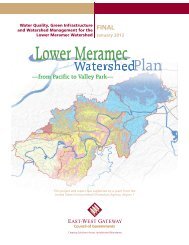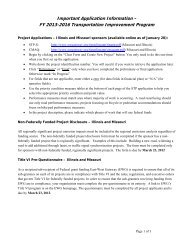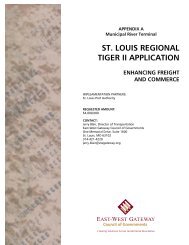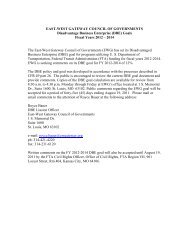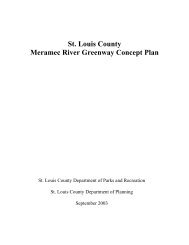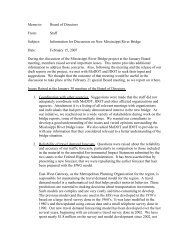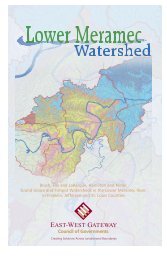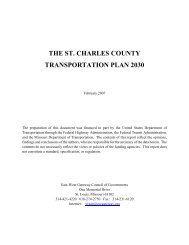Jefferson County - East-West Gateway Coordinating Council
Jefferson County - East-West Gateway Coordinating Council
Jefferson County - East-West Gateway Coordinating Council
You also want an ePaper? Increase the reach of your titles
YUMPU automatically turns print PDFs into web optimized ePapers that Google loves.
A Regional Overview All-Hazard Mitigation Plan 105<br />
Early in this century, as many dams failed due to lack of proper engineering and<br />
maintenance, it was recognized that some form of regulation was needed. One of the<br />
earliest state programs was enacted in California in the 1920s. Federal agencies, such as<br />
the Corps of Engineers and the Department of Interior, Bureau of Reclamation built many<br />
dams during the early part of the twentieth century and established safety standards<br />
during this time. Slowly, other states began regulatory programs. But it was not until the<br />
string of significant dam failures in the 1970s that awareness was raised to a new level<br />
among the states and the federal government.<br />
In Missouri, the first state legislation aimed at regulating dams was passed in 1889 and<br />
was called the Dam Mills and Electric Power Law. The law was concerned only with<br />
damaged caused by construction and lake formation. It did not address the engineering<br />
aspects of design or downstream safety of dams.<br />
In 1972, Congress passed the National Dam Safety Act (P.L. 92-367) that called for an<br />
inventory of dams in the U.S. and one time inspection of dams that would result in loss of<br />
life from a failure. In 1986, Congress enacted the Water Resources Development Act (P.L.<br />
99-662). Title XII-Dam Safety authorized the U.S. Army Corps of Engineers (USACE) to<br />
maintain and periodically update the inventory of dams. In 1988 funds were appropriated<br />
for this effort. FEMA and USACE developed a Memorandum of Agreement where FEMA<br />
assumed responsibility for maintaining and updating the inventory using the funds<br />
authorized. The Water Resources Development Act of 1996 (P.L. 104-303) Section 215 reauthorized<br />
periodic update of the National Inventory of Dams (NID) by USACE and<br />
continued a funding mechanism. For the 1998 update, the USACE resumed the lead<br />
responsibility and worked with FEMA and other agencies. There are about 77,000 dams in<br />
the inventory.<br />
Federal law and the Association of Dam Safety Officials (ASDSO) Model State Dam Safety<br />
program define a dam as “any artificial barrier, including appurtenant works, which<br />
impounds or diverts water and which 1.) is 25 feet or more in height from the natural bed<br />
of the stream or watercourse measured at the downstream toe of the barrier, or from the<br />
lowest elevation of the outside limit of the barrier, if it is not across a stream channel or<br />
watercourse to the maximum water storage elevation; or 2.) has an impounding capacity<br />
at the maximum water storage elevation of fifty acre-feet or more.<br />
This Act does not apply to any such barrier which is not in excess of six feet in height,<br />
regardless of storage capacity, or which has a storage capacity at a maximum water<br />
storage elevation not in excess of fifteen acre-feet, regardless of height (P.L. 92-367; Dam<br />
Safety Act of 1972) unless such barrier, due to its location or other physical characteristic,<br />
is likely to pose a significant threat to human life or property in the event of its failure.”<br />
(P.L. 99-662, Water Resources Development Act of 1986).<br />
Criteria for dams in the NID are as follows:<br />
1). All high hazard potential classification dams



